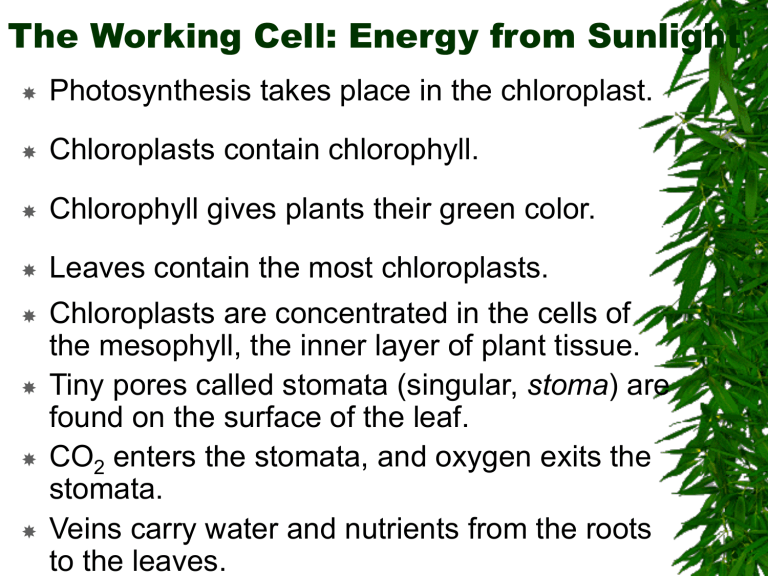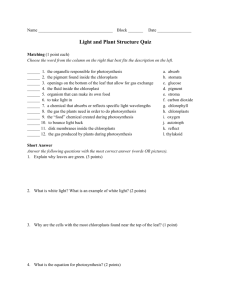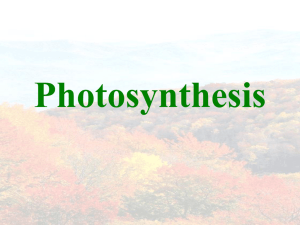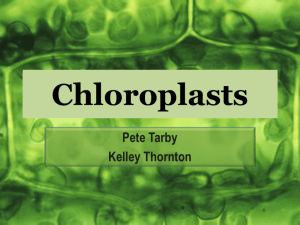The Working Cell: Energy from Sunlight

The Working Cell: Energy from Sunlight
Photosynthesis takes place in the chloroplast.
Chloroplasts contain chlorophyll.
Chlorophyll gives plants their green color.
Leaves contain the most chloroplasts.
Chloroplasts are concentrated in the cells of the mesophyll, the inner layer of plant tissue.
Tiny pores called stomata (singular, stoma ) are found on the surface of the leaf.
CO
2 enters the stomata, and oxygen exits the stomata.
Veins carry water and nutrients from the roots to the leaves.
Figure 8-2
Photosynthesis takes place in cellular organelles called chloroplasts. In this sunflower, the greatest numbers of chloroplasts are located in the leaves. Chlorophylls give the chloroplasts —and in turn the leaves—their green color.
Chloroplasts
Chloroplasts have an inner and outer membrane.
The inner membrane encloses a thick fluid called stroma.
Suspended in the stroma are many disk-shaped sacs call thylakoids.
Thylakoids are arranged in stacks called grana.
These structures within chloroplasts organize the chemical reactions that make up photosynthesis.
2 Main Stages of Photosynthesis
Light Reactions and the Calvin Cycle:
1.) Light Reactions :
convert sunlight --> chemical energy
occurs in the membranes of the thylakoids.
Result in the formation of NADPH and ATP .
2.) Calvin Cycle : dark reactions
Makes sugar from- carbon dioxide, H, and
NADPH
Occurs in the stroma.
Light-independent reactions
Overview of
Photosynthesis
Electromagnetic Energy
Sunlight is a type of electromagnetic energy.
Electromagnetic energy travels in waves.
The distance between 2 waves is wavelength.
The range between different types of electromagnetic energy is called the electromagnetic spectrum .
Visible light —wavelengths your eyes see as different colors —makes up only a small fraction of the electromagnetic spectrum.
Visible light consists of wavelengths from 400 nanometers (nm), violet, to 700 nm, red.
Shorter wavelengths have more energy than longer wavelengths.
Wavelengths shorter than visible light have enough energy to damage organic molecules such as proteins and nucleic acids.
This is why exposure to the ultraviolet (UV) radiation in sunlight can cause sunburns and lead to skin cancer.
Seeing Color
• The color of an object is the color that it reflects.
Color- Why do we see colors?
A substance’s color is due to chemical compounds called pigments.
When light shines on a material containing pigments, different wavelengths of light can be absorbed, transmitted or reflected.
A red object reflects red light, but absorbs all other wavelengths of light.
Why are leaves green?
Pigments in the leaf's chloroplasts absorb blue-violet and red-orange light.
Chloroplast pigments do not absorb green light well.
Most of the green light passes through the leaf (is transmitted) or bounces back (is reflected).
Leaves look green because the green light is not absorbed, the green light is reflected or transmitted through the leaf.
Chromatography
Chromatography is used to separate and analyze the different pigments in a leaf.
Chloroplasts contain chlorophyll a and chlorophyll b, as well as other helper pigments.
Chlorophyll a absorbs mainly blue-violet and.
red light and reflects mainly green light.
It plays a major role in the light reactions of photosynthesis.








